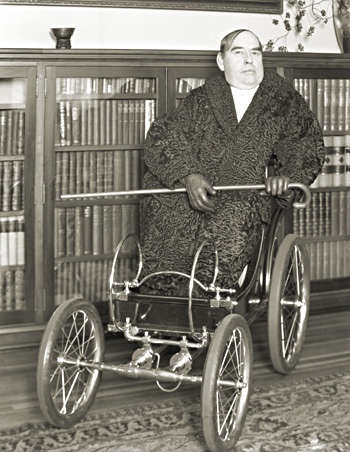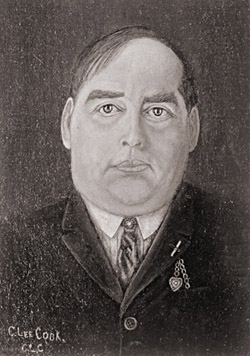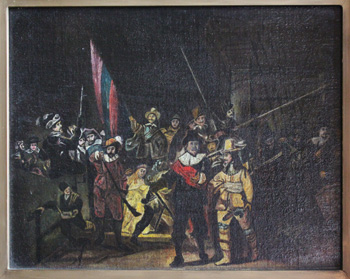| HOME | THE HOUSE | THE NEIGHBORHOOD | TIMELINE | DIRECTIONS | CONTACT |
A Historical Tribute
1244 S. Sixth St. - pre-19281244 Sixth Street
Charles Lee Cook - The Inventor, Engineer, Industrialist...

C. Lee Cook - circa 1927
A Genius Who Never Walked A Step
As the subject of an article printed in American Magazine in 1920, Mr. Cook was called “A Genius Who Never Walked A Step.” At age one, stagnation of muscular development began to appear. By age 14 he had been diagnosed with polio and endured curvature of the spine. Though he showed an aptitude for learning, his parents discontinued his schooling before he was seven thinking he wouldn’t live to reap the benefits of a proper education.
The young Mr. Cook showed great mechanical ingenuity and spent a good deal of time in his little workshop in the family stable behind their house near the K&I Railroad yards in the Portland neighborhood. He exhibited extraordinary talent building a steam engine which worked at age eight, a functioning miniature duplicate of a steam towboat at age 12, and later a steam fire engine that could throw a stream of water fifty feet despite being less than eight inches high and seven pounds in weight. All impressive considering Mr. Cook spent his entire life in a wheelchair, and his only physical dexterity was limited use of his right arm and hand.
A Better Piston Ring
It was locomotives that led to the foundation of the C. Lee Cook Company. Watching a railroad cut being excavated, he noticed steam escaping with each stroke of the piston on the powerful engine. He questioned the engineer as to why the steam was allowed to escape. The reply was simply that no one had been able to find a method to prevent this waste for any length of time. At that, Mr. Cook set out to find a solution. His invention--the first in a long line to his credit--was a novel kind of metallic packing. Once he had perfected his device, it was placed on a Louisville and Nashville locomotive where it ran one hundred and seventy-five thousand miles without repair. During World War I, the Allied shipping concerns began utilizing the new piston ring design. His packing was used on nearly all American ships.

Caufield and Shook Collection
Scholarly Pursuits
Mechanical achievements, however, were only a portion of his legacy. Following a humiliating experience giving a speech in which his grammar was ridiculed, Mr. Cook began an intensive study of the English language, even tracing many words into Greek, Latin, Hebrew, and Sanskrit.
Renaissance Man, Community Leader
His accomplishments included a talent for painting, attending law school at the age of 36, and even being considered for appointment to the United States Senate. Mr. Cook took an active role in the community, serving as Chairman of the Board of Trustees of the Warren Memorial Presbyterian Church, a member of the Board of Trade, The Filson Club, Naval Architects and Engineers Club, and an honorary life member of the Louisville Rotary Club. He also participated in numerous fundraising projects, including the construction of the Kentucky Children’s Home Society in Lyndon.

C. Lee Cook - circa 1927
Legacy
Charles Lee Cook died April 25, 1928 at his home, at the age of 57, from bronchial pneumonia. In an editorial the Louisville Courier-Journal referred to him as “...a genius probably without parallel in history.” He left an inheritance to every part of this company--a brilliant example of perseverance and determination. He was survived by his wife, Elma Cook. Directions to the family gravesite in Cave Hill Cemetery can be found here.
His invention of a floating mechanical packing to reduce steam leakage from the piston rods of steam engines still serves as the basis for a major portion of his company’s product line today.
In 1955, C. Lee Cook along with Rotary Lift, Peerless Manufacturing, and the W. C. Norris Company were merged to form Dover Corporation (so named because it was incorporated in Dover, Delaware). Fred Durham, Cook's owner following Mr. Cook's death in 1928, became Dover's first President and Chairman, and guided Dover's growth until his retirement in 1970. While Dover Corporation has acquired more than a hundred companies since its founding, C. Lee Cook, now known as Cook Compression, has the distinction of being one of the original companies that make up what is now a six billion dollar plus corporation.
The C. Lee Cook Company operated on a 4 acre site at 8th St. and Kentucky St., near downtown Louisville, KY, beginning in the late 1800’s, and lasting well into the 21st century, before moving production across the Ohio river to Jeffersonville, IN in 2009. All of the Cook buildings on 8th St. were leveled in 2013. His legacy lives on today as Cook Compression which has manufacturing operations in the U.S. and Service Centers around the globe.
The Artist

The Night Watch - C. Lee Cook
after Rembrandt van Rijn
Mr. Cook enjoyed painting as a hobby. "The Night Watch" is his version a copy of a famous painting that he created by having his servant dip his brushes into the paint and then bring his hand up to the canvas. The servant also had to move the canvas board for him so he could paint a different area.
C. Lee Cook's “The Night Watch”, is not signed, and measures 10 1/2" by 8 1/4", much smaller than the original which is 11.91 ft × 14.34 ft. From the collection of Martin Davenport, grandson of Fred Durham, who took over ownership of the C. Lee Cook Corporation after the death of Mr. Cook.
The Patents
C. Lee Cook had many patents to his name. You can download and view PDFs of the patents on the patents page.
The Quotes and Magazine Article
C. Lee Cook acquired a great deal of wisdom about success in life, from his point of view, confined to a wheelchair. You can read the published quotes on the quotes page. The American Magazine article from April 1920 is there too, and it is available to download as a PDF file here.
| HOME | THE HOUSE | THE NEIGHBORHOOD | TIMELINE | DIRECTIONS | CONTACT |